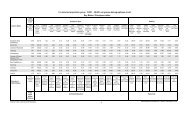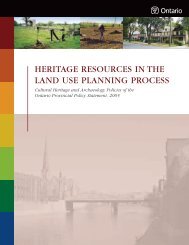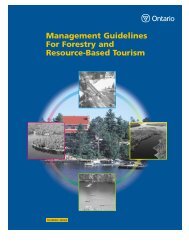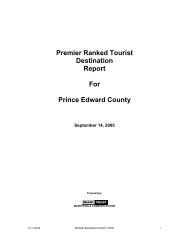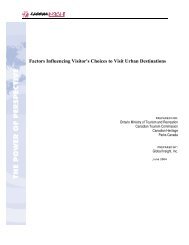includes parcels <strong>of</strong> land that are separated by anintervening road allowance, trail, etc.Project LocationO. Reg. 359/09 requires consideration <strong>of</strong> heritageresources at the project location. Projectlocation is defined as a part <strong>of</strong> land and all or part<strong>of</strong> any building or structure in, on or over which aperson is engaging in or proposes to engage inthe project and any air space in which a person isengaging in or proposes to engage in the project.This includes all land, buildings or structures whichmay be impacted by activities for all projectphases (i.e. the construction, installation,operation and use, changing or retiring <strong>of</strong> thefacility).Study AreaAs the project location may be situated within acultural heritage landscape, for the purposes <strong>of</strong>the heritage assessment MTCS recommends thatthe qualified person consider the whole property(or properties) on which project components arelocated. Assessing a cultural heritage landscapeinvolves looking beyond the footprint <strong>of</strong> the projectand analyzing the surrounding area. As culturalheritage landscapes are included in the definition<strong>of</strong> ‘heritage resource’, defining a broader studyarea is an important step in determining impacts tothis type <strong>of</strong> heritage resource.ImpactsEvaluating impacts can be broadly defined as theprocess <strong>of</strong> identifying, predicting, and evaluatingthe cultural, biological, physical, social and otherrelevant effects <strong>of</strong> the renewable energy project.With respect to a renewable energy project,alteration refers to the erection or construction <strong>of</strong>project components on the property which mayimpact views and vistas, alter the existinglandscape, require demolition <strong>of</strong> existing buildingsor structures, or have other impacts on heritageresources. Project components include not onlyprimary elements such as wind turbines or solarpanels, but also secondary elements such asaccess roads, laydown areas, etc.Impacts can be temporary (e.g., dust and vibrationduring construction) or longer term (e.g., visualintrusions <strong>of</strong> new or modified infrastructure). Theheritage assessment report must identify anddescribe the extent <strong>of</strong> all potential impacts;describe how each identified heritage resourcemay be impacted with reference to the specificcultural heritage value <strong>of</strong> the resource; andexamine mitigation options and project changes toprevent or reduce negative impacts. Finally, theheritage assessment report must recommend amitigation option and explain why it is preferred.Additionally, assessing a larger study area is abest practice that encourages identification <strong>of</strong>heritage resources early in the design phase andallows for a broader range <strong>of</strong> options for avoiding,eliminating or mitigating impacts. This approachprovides proponents with greater flexibility shouldthey have to alter the project layout either becauseadditional environmental constraints are identifiedat a later stage, or as a result <strong>of</strong> the consultationand engagement process.6
2.2: InvestigationThis section provides guidance on how to conduct an investigation, including historicalresearch and visual inspection.There are five steps involved in undertaking a siteinvestigation:1. Identify the study area.2. Consult with municipal staff, Aboriginalcommunities, heritage organizations and thepublic to learn more about the cultural heritage<strong>of</strong> the community.3. Apply preliminary criteria to screen for knownand potential heritage resources and createan inventory.4. Analyze inventoried resources through a sitevisit.5. Investigate inventoried resources throughfurther historical and archival research,historical maps, municipal records andinterviews.1) The Study Area:For the purposes <strong>of</strong> the heritage assessment,considering a larger study area is a recommendedbest practice. The study area may be defined asthe geographic area that may be altered orimpacted because <strong>of</strong> the proposed project.The nature <strong>of</strong> the existing terrain, land elevations,vegetation, waterways, roadways, rail corridors,protected properties and known heritageresources, along with any other relevantenvironmental factors should be considered whendefining the study area. The study area andproject location should be clearly depicted on amap that is included in the final report.2) Community Input:Under O. Reg. 359/09, the applicant is required toconsult with the public, municipalities, andAboriginal communities regarding the proposedproject. The person conducting the heritageassessment should make their best efforts toensure that any heritage concerns brought forwardduring early public meetings and through anyengagement with Aboriginal communities areincorporated into the heritage assessment.Proactive engagement with community memberscan save the proponent from having to makecostly alterations to project layouts if a heritageconcern is brought forward at the final publicmeeting, or after the application is submitted toMOE.<strong>Heritage</strong> and archaeological sites are <strong>of</strong> criticalimportance to First Nations, Métis and Inuitcommunities. Aboriginal communities may haveinformation about heritage sites that are <strong>of</strong> specialimportance to their community and should beinvolved in the assessment process. Informationabout cultural heritage resources should berequested during the formal Aboriginalengagement process. Please note that traditionalknowledge may be considered sensitive. Forfurther information on engaging Aboriginalcommunities please see MTCS’ Draft TechnicalBulletin: Engaging Aboriginal Communities inArchaeology. Although this document refersspecifically to archaeology, it provides generalbackground material on effective approaches toengaging with Aboriginal communities overall.Municipal staff will be a helpful resourcethroughout the identification and evaluationprocesses. If the municipality has a municipalheritage planner and/or a Municipal <strong>Heritage</strong>Committee (MHC), they should be contacted whenconducting the heritage assessment. The localcommunity may also have a historical society,heritage museum, Architectural Conservancy <strong>of</strong>Ontario (ACO) local chapter, or other localheritage interest groups that may be consulted.Information can also be gathered from localheritage groups, librarians, museum curators andhistorians, as well as published local histories.These sources will help to establish thecommunity context and identify historical themesthat can be used in screening for potential heritageresources. Community members may also directthe qualified person to important heritageresources that are not easily identifiable througharchival sources or site visits.The objective <strong>of</strong> consulting with interestedindividuals and groups is to identify all potentialand known cultural heritage resources that may beaffected by the proposed development. Engaginginterested parties early in the heritage assessmentprocess can help to ensure that review is not



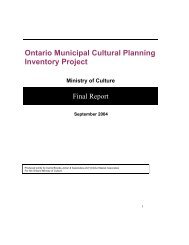
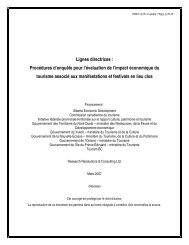
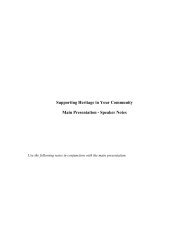
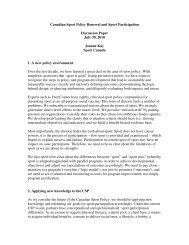
![THIS AGREEMENT made this [date], between [name of owner] (the ...](https://img.yumpu.com/49827605/1/158x260/this-agreement-made-this-date-between-name-of-owner-the-.jpg?quality=85)

